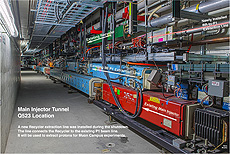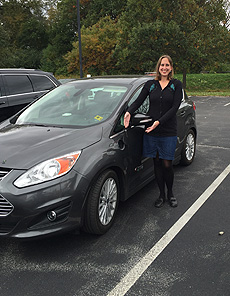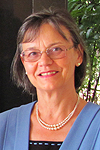|
|
Accelerator wakes from shutdown slumber
 |
Many laboratory departments, led by the Accelerator Division, contributed to improvements in the Main Injector during the 13-week accelerator shutdown, which ended on Oct. 5. Photo: Reidar Hahn |
Cons Gattuso, Accelerator Division shutdown manager, keeps a digital spreadsheet of everything that needed to be done during the Fermilab accelerator complex's 13-week shutdown, which ended on Oct. 5. In total, it's about 2,700 items, including both upgrades and routine maintenance. It's a to-do list of monstrous proportions.
Upgrades to support muon experiments were the main driving force of the shutdown, primarily the installation of a new line that will deliver an 8-gigaelectronvolt proton beam to the Muon Campus. Installing this beamline was one of the hardest items to cross off the list. Crews had to thread the new beamline through a congestion of pre-existing beamlines. By disassembling and reassembling existing beamline, they managed to sneak it in — but just barely.
"In some locations, we had less than a tenth of an inch of space between components when we were done," Gattuso said.
During the shutdown, crews also removed old, unused Tevatron parts, built two office-sized anode power supplies for the Booster's beam-accelerating radiofrequency system and replaced the NuMI beam's magnetic focusing horn.
Crews removed the old horn with a remote-controlled crane and put it in a special holding cell to let it cool off. Because old horns are too radioactive to fix, a brand new horn replaced the old one, ensuring that the accelerator complex will continue to deliver a quality particle beam to the laboratory's neutrino experiments.
Crews pulled almost half a million feet of new cable, shuffled close to 2,500 tons of magnets and blocks, and modified nearly three-quarters of a mile of vacuum systems during shutdown. To execute work of such enormous size in the allotted timeframe, the Accelerator Division received labwide assistance.
"Without having that help from across the laboratory, there's no way we would have been able to do this," Gattuso said. "For some 13 weeks we came together as one laboratory in our tunnels working hand in hand to make this shutdown the success that it is. Kudos goes out to everyone."
Merely swapping out one magnet requires the involvement of between 40 and 50 people from various departments and groups. Gattuso estimates that a couple hundred people moved in and out of the accelerator's tunnels during its slumber. Many of those who didn't actually journey into the tunnels labored elsewhere on to-dos or shared their equipment. Ultimately, this unity and collaboration allowed the accelerator to be up and running on time.
"On behalf of the entire Accelerator Division, I would like to thank our Fermilab colleagues for helping us accomplish our shutdown plan," said Sergei Nagaitsev, head of the Accelerator Division.
With the accelerator complex's hibernation over, things are less hectic for Gattuso, who joked that he might go golfing. His sigh of relief will be short-lived, however.
"Now we will start preparing for the next shutdown," Nagaitsev said.
—Chris Patrick
|
Sculpture in the sun
 |
| The sun rises over Swan Lake and "Acqua Alle Funi." Photo: Judy Nunez, TD |
|
How neutrinos, which barely exist, just ran off with another Nobel Prize
From The Conversation, Oct. 6, 2015
Neutrinos take patience. They're worth it, and the announcement of the 2015 Nobel Prize in physics recognizes that, following related prizes in 1988, 1995 and 2002. Ironically, these near-undetectable particles can reveal things that cannot be seen any other way.
I could begin by telling you that neutrinos are elementary particles, but that sounds condescending. They're not called elementary because they're easy to understand — they aren't — but because they are seemingly point-like in size, and we can't break them down into smaller constituents. There's no such thing as half a neutrino.
Read more
|
Dark matter may power supernovae
From Physics World, Oct. 7, 2015
Stellar explosions known as type Ia supernovae could be triggered by dark matter. So says a physicist in the US, who has worked out how certain burnt-out stars can explode even though they lack the mass to generate fusion reactions. According to the new research, the stars ignite because they accumulate so-called asymmetric dark matter, which, if real, could be detectable in a new generation of earthbound experiments.
Read more
|
|
Do you drive an electric vehicle? Tell us about it
 |
Kimberly Myles, CCD, drives a plug-in hybrid to work. Do you drive a plug-in vehicle to Fermilab? If so, we want to hear from you. Photo: Adam Walters, CCD |
Do you drive an electric vehicle (EV) or plug-in hybrid to work? Would you like to be able to charge your car at Fermilab? The Sustainability Committee wants to hear from you if you do, or even if you plan to in the future. Take a minute to send an email to rwalton@fnal.gov and let us know what you drive, how often, the distance you commute, and if you would be interested in on-site charging stations if they were available for a nominal fee. If you know of anyone else who commutes electric, let us know so we can contact him or her.
Part of the new Executive Order 13693, Planning for Federal Sustainability in the Next Decade, urges federal facilities to encourage employees to commute to work in electric or plug-in hybrid vehicles to decrease the amounts of greenhouse gas emissions. Having a charging station available at work can be valuable by ensuring that your vehicle is topped off and ready to go when it's time to leave work. A complete charge with a 240-volt charger can take as little as an hour, and a "quick charge" to 80 percent of capacity, less than a half hour. The fee for charging at other DOE sites ranges from zero to $1.25 per charge — certainly less than topping off the petroleum tank!
Several DOE sites, including DOE Office of Science headquarters at Germantown, Maryland, have instituted this service for employees. Although there are a number of obstacles, including how to pay for the electricity, other DOE sites, including Argonne, Brookhaven, Oak Ridge, the National Renewable Energy Laboratory and Pacific Northwest, have found various means to overcome them. If Fermilab is to consider making charging stations accessible to employees and users, we need to have a better idea of the potential demand among our population, and you can help by providing us data.
Driving an EV helps the environment by significantly lowering the amount of carbon dioxide emitted into the air per mile, and the vehicles can potentially save money for the owner, since electrical power is relatively inexpensive. Although EVs are more expensive to buy, the cost can be offset by the cheap power and various tax incentives. The federal tax incentive can be as much as $7,500. Although Illinois has suspended the tax incentive program, electric vehicles are eligible for a special two-year license plate registration for $35, which is a substantial reduction from the usual $101 per year fee.
So, please respond to the above email soon and weigh in on the desirability of charging stations on our site.
—Rod Walton
|
Magdolna Hargittai talks about successful women scientists - today in One West
 |
|
Magdolna Hargittai
|
The Fermilab Women's Initiative invites everyone to hear Magdolna Hargittai present her talk "Successful Women Scientists around the Globe" today at 3 p.m. in One West.
The talk, based on Hargittai's book "Women Scientists: Reflections, Challenges, and Breaking Boundaries," draws on in-depth conversations with many of the most successful women scientists of our time. The featured women include not only American and European success stories, but also scientists from countries less often discussed in such a context, such as India, Japan, Russia and Turkey. The women introduced represent different scientific fields, including some who have gone on to hold important administrative positions.
Hargittai is a professor of chemistry at the Budapest University of Technology and Economics. A recipient of the 2011 Science Communication Award of the Club of Hungarian Science Journalists, she has published broadly on symmetry and women scientists.
|
Guido Altarelli (1941-2015)
From CERN Bulletin, Oct. 5, 2015
The CERN community was deeply saddened to learn that Guido Altarelli had passed away on 30 September.
He was a true giant of particle physics and of CERN. His contributions to physics span all subjects, from strong to electroweak interactions, from neutrinos to theories beyond the Standard Model, and from the study of precision measurements to the analysis of apparent anomalies, whose interpretation in terms of new physics he often exposed as naïve and unjustified. He left milestones in the progress of our field wherever he went. The awards of the Sakurai Prize in 2012 and of the EPS Prize in 2015 rank him among the greats, and reflect only in part the wealth of knowledge he gave to high-energy physics.
Read more
|
|